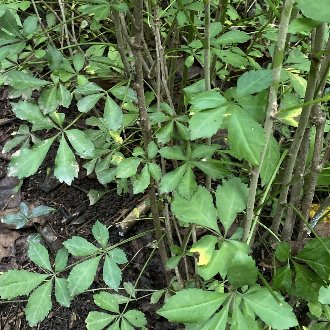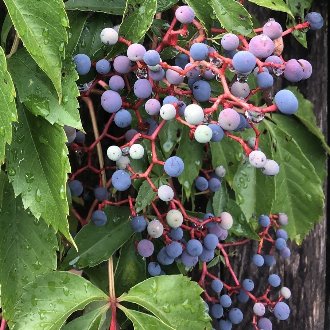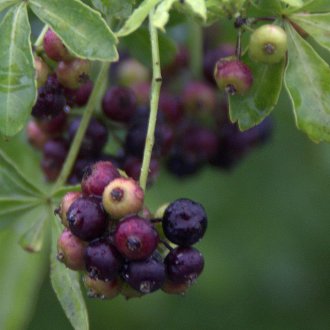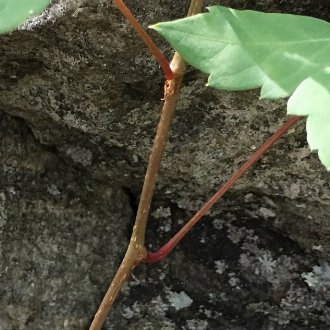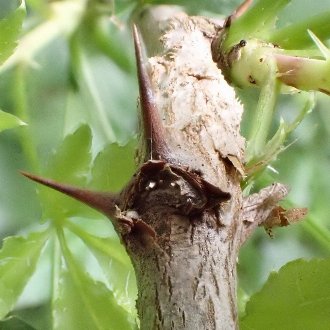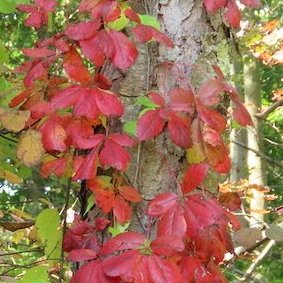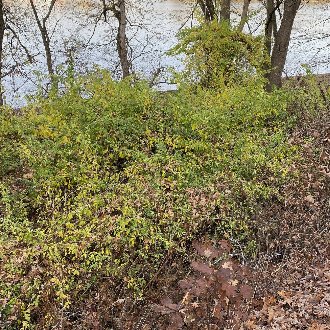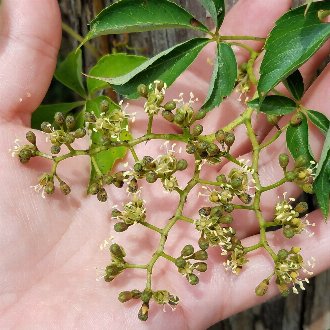Virginia Creeper vs Five-Fingered Aralia
These two species, not closely related, are frequently confused due to superficial similarities: not only are their 5-leaflet compound leaves similar, but they also have inconspicuous green flowers and dark purple fruit. They are easily distinguished by growth habit, presence or absence of thorns or climbing tendrils, and the shape and color of the inflorescence and fruit cluster. Parthenocissus quinquefolia is native and widespread in North America, whereas Eleutherococcus sieboldianus is an introduced, potentially invasive species which is only rarely planted in landscaping, but frequently escapes into the wild near where it is planted.
Virginia Creeper (Parthenocissus quinquefolia) | Five-Fingered Aralia (Eleutherococcus sieboldianus) |
A woody vine native to much of east and central North America, climbing via adhesive discs. | A shrub native to China, occasionally planted in the US, and when it does, often escaping and becoming invasive. |
Vining habit, not supporting its own weight, and climbing via tendrils tipped with adhesive discs, trailing on the ground when it cannot climb. Photo © Sandy Wolkenberg, CC BY 4.0. | Usually grows as a free-standing shrub, occasionally seeming vine-like due to sprawling over nearby vegetation, but never climbing with tendrils or adhensive discs. Photo © Emily Summerbell, CC BY 4.0. |
Fruit arranged in an irregular, branching cluster, fruits variably pale blue through shades of lavender and purple when unripe, to deep blue when ripe. Stems turn bright red before fruit ripens. Photo © Andrew Conboy, CC BY 4.0. | Fruit arranged in a small, regular globe-shaped cluster. Unripe fruits pale green through reddish purple, to purplish-black when ripe. Stems of clusters stay green as fruit ripens. Photo © manuel m. v., CC BY 2.0. |
Plants lack thorns. Photo © Ryan Hearty, CC BY 4.0. | Plants have thorns. Photo © Taro Ietaka, CC BY 4.0. |
Leaves turn bold red in autumn, and are completely dropped earlier, usually around the same time as or even earlier than other deciduous vegetation. (Photo from early October in Western Pennsylvania) Photo © Theo Rickert, CC BY 4.0. | Retains leaves longer in autumn, usually much longer than surrounding deciduous vegetation. Leaves stay green well into late fall, slowly turning only yellow, never bold red. (Photo from early November in Western Pennsylvania) Photo © Mason Heberling, CC BY 4.0. |
Leaflets may be sessile (attached directly without a stalk), but may also have a short petiole. Photo © William Kimzey, CC BY 4.0. | Leaflets are always sessile (attached directly to a common point, without a stem of their own), tapered at the base but lacking a true petiole. Photo © Reuven Martin, Public Domain. |
Flowers in irregular, branching clusters, in small groups of flowers that tend to have staggered opening times. Flowers much later, typically mid-summer. Photo © Leila Dasher, CC BY 4.0. | Flowers in non-branching, globe-shaped clusters, where all flowers tend to open about the same time. Flowers much earlier, typically late spring. Photo © mecarr, CC BY 4.0. |
References & External Resources
These short lists show only links helpful for ID. For a complete list of references and resources also covering other aspects of ecology, visit the links section of the full article on each plant, which is the first entry here.




